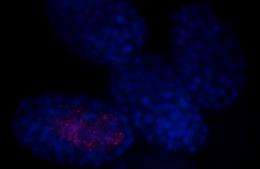Genes, environment, or chance?

Biologists attribute variations among individual organisms to differences in genes or environment, or both. But a new study of nematode worms with identical genes, raised in identical environments, has revealed another factor: chance.
It's another source of variation for scientists to consider. "Researchers have been exploring whether organisms evolve different ways to cope with genetic and environmental variation," said author Scott Rifkin, an assistant professor of biology at UC San Diego. "This study adds random variation to that mix."
Rifkin, who joined the UCSD faculty this fall, completed the study while working at MIT. The paper, co-authored by Arjun Raj, who contributed equally to the work, Erik Andersen and Alexander van Oudenaarden of MIT, is published in the February 18 issue of Nature.
Rifkin and his colleagues looked at the development of the gut in C. elegans. In many, but not all worms with mutations in a gene called skn-1, the gut failed to develop, even when the embryos were genetically identical and incubated together.
"Often when people look at variation in a trait among organisms they try to trace it back to genetic differences or differences in environmental conditions or some combination of the two. In our study there were no such differences, and so we hypothesized that the only other source for the variation could be differences that arose at random during the process of development," Rifkin said.
The mutated gene is the first in a series of several genes that control each other in sequence to determine whether the gut precursors begin to develop into intestinal cells.
In mutant worms, the final gene was either on or off, and that determined whether an embryo developed gut cells or not. But the activity of an intermediate gene varied widely. That's where chance seems to play a role.
Some mutant cells transcribed the gene many times, ultimately creating enough of the protein to activate the final gene. Others made too few transcripts and the final gene stayed off.
DNA winds tightly around proteins, like thread around a spool, and must uncoil for the transcriptional machinery to access a gene.
Some proteins unwind the DNA; others wind it up again. In the mutant worms, the balance shifted to favor the proteins that keep DNA wound. But in some of the worms, the DNA stayed uncoiled long enough to generate sufficient numbers of transcripts to activate the final gene. And so, by chance, those worms developed a gut.
Provided by University of California - San Diego

















